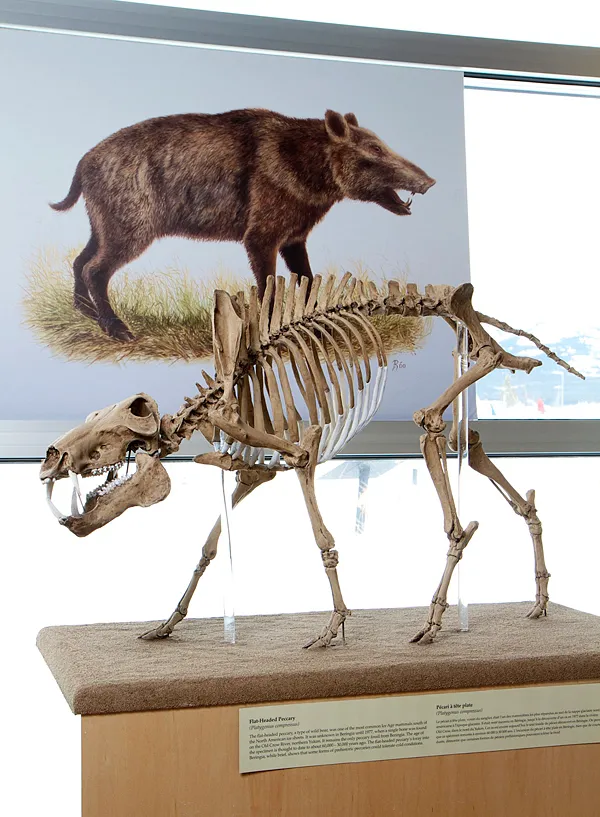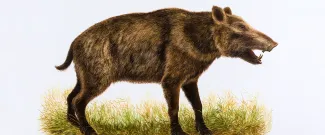
Peccaries have a long history of evolution in North and South America and are distantly related to the true pigs of Europe and Asia. The flat-headed peccary (Platygonis compressus) was about the size of a European wild boar (Sus scrofa); about 75 centimetres in height at the shoulder. Ice age peccary skulls suggest a small brain with a strong sense of smell and sight. Their oversized noses and nasal cavity may have provided filtration of the dry, dusty air blowing across the ice age landscape.
The ice age flat-headed peccary is best known from sites across the United States and as far south as Mexico. Peccaries are usually found in groups or even small herds. Groups of fossilized skeletons representing whole herds of flat-headed peccaries have been found in Texas, Missouri and Kentucky. At Bat Cave in Missouri, fossils from at least 98 individuals were recovered together, suggesting repeated use of the cave by herds over many years. A site at Hickman, Kentucky revealed a herd of flat-headed peccaries that were killed in a dust storm. The position of the fossilized skeletons indicated their backs were turned to the wind, but the dust eventually got the best of them and they all suffocated.
Flat-headed peccaries went extinct near the end of the Ice Age around 11,000 years ago, along with many of the other large ice age mammals. There is no evidence that ice age people hunted them to extinction. Perhaps they could not cope with the rapid climate changes and their populations never recovered.
Yukon's Ice Age Pigs
Only two peccary fossil bones have ever been identified in Yukon. The first bone was a broken part of a lower front limb (the radius) and was discovered along the Old Crow River in 1977. The discovery extended the known distribution of these animals north my over 3,000 kilometres! Prior to that they were only known to have existed in the mid-continental United States. Palaeontologists never imagined peccaries could have lived above the Artic Circle during the Ice Age! The second fossil bone was found at Independence Creek in 2015.
Scientists really do not know when flat-headed peccaries lived in Yukon. The single fossil bone from Old Crow is quite small, and so far neither specimen has been radiocarbon dated. It is likely that peccaries only ventured north to arctic latitudes during the warm interglacial period around 125,000 years ago. Climate conditions at this time seem to have been right for the northward migration of many ice age mammals centred in the south, like the American mastodon and Jefferson's ground sloth. The rarity of peccary fossils in Yukon suggests that few individuals made it as far north as Yukon, and those that did, didn't survive here for long.
Want to learn more? Check out the Beringian Research Notes about the flat-headed peccary.

One of the first fossils ever discovered in North America was a peccary skull found in a Kentucky cave in 1804 or 1805. The skull sat in a museum collection until it was described and named in 1853.

